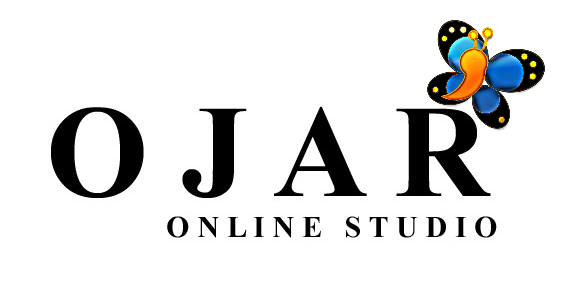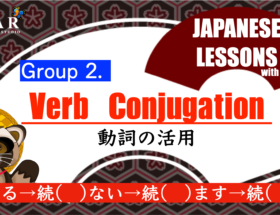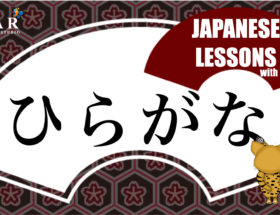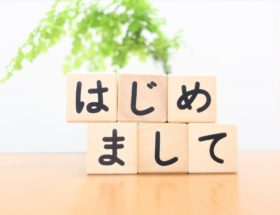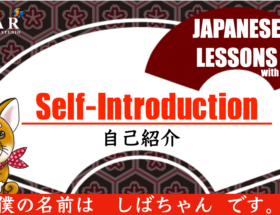Hi, I’m ojachan 🙂 Today’s lesson is;【第9課】 Lesson 9. Watashi wa Anata ga Sukidesu
If you want to learn lesson 8, you can learn from HERE!
Don’t you want to know how to learn Japanese like Japanese kids? This lesson is meant for students that are beginners at Japanese.
⭐️This lesson is following the textbook “Minna no Nihongo”. (*not perfectly)
⭐️I’m going to give a lesson easier to understand for Japanese learners without following textbook’s orders.
Let’s get started!
CONTENTS
Key Phrases
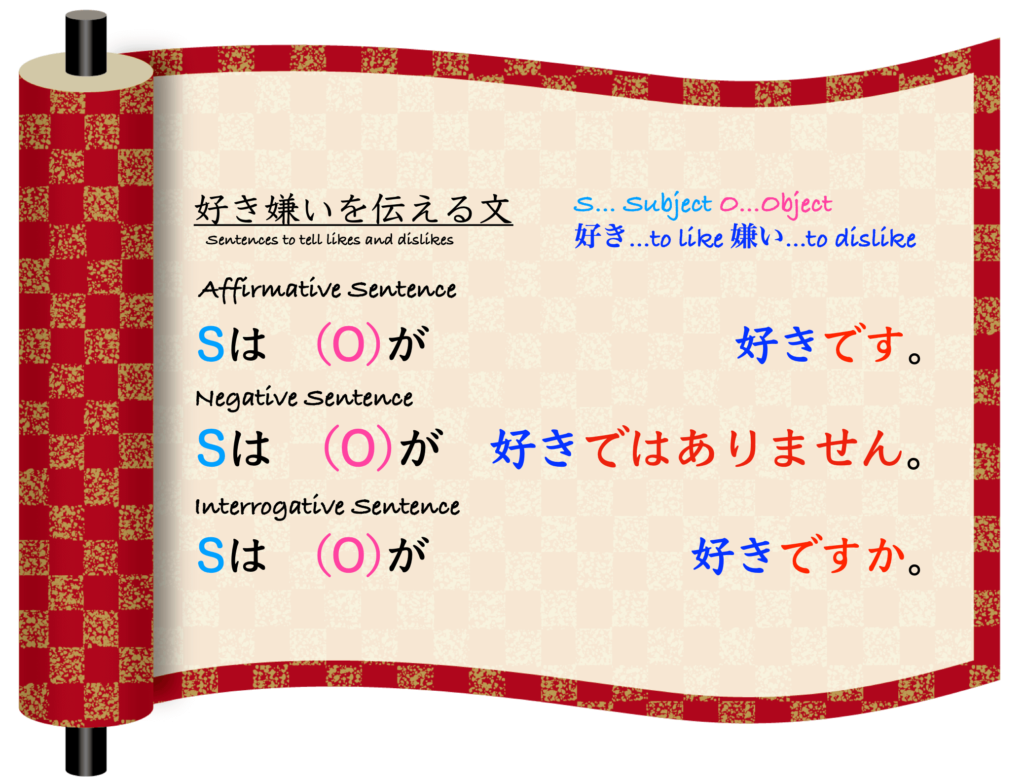
| わたしは あなたが 好きです。 watashi wa anata ga sukidesu I like you. わたしは あなたが 好きではありません。 watashi wa anata ga sukidewaarimasen I don’t like you. あなたは わたしが 好きですか。 anata wa watashi ga sukidesuka Do you like me? はい、好きです。 hai sukidesu Yes, I do. いいえ、好きではありません。 iie sukidewaarimasen No, I don’t. |
| あなたは どんな人が 好きですか。 Anata wa donna hito ga sukidesu ka What’s your type of girls do you like? わたしは 優しい人が 好きです。 washi wa yasashii hito ga sukidesu I like someone with a kind heart. |
The Difference Between “は wa” and “が ga”
It’s very difficult and confusing expressions of the difference between は and が.
I’m going to try explain the differences in my own way.
Japanese kids learn は as 副助詞 fukujoshi, and が as 格助詞 kakujoshi.
| が | は |
|---|---|
| 格助詞 kakujyoshi joshi | 副助詞 fukujyoshi |
| to make a subject to show a new information to emphasize the topic | to make a subject to show a general or an old information to distinguish the others |
What is 副助詞 and 格助詞?
📎 It’s difficult topic a little so you can skip what are 副助詞 and 格助詞.
・副助詞 is the participle that can add meaning to various words.
副助詞 is like a commentator.
・格助詞 mainly follows a noun. And it shows what kind of functions the noun is for the other words.
格助詞 is like an anchor.
So the both functions are totally different.
the Usage of は wa
1. To Make a Subject
You can use は to make a subject generally.
| おじゃちゃんは 先生です。 ojachan wa sensei desu Ojachan is a teacher. |
2. To Show a General or an Old Information
■ General Information
You can use は if you want to tell general things.
| ピカチュウは 黄色です。 Pikachuu wa kiiro desu Pikachu is yellow. |
I think everyone knows Pikachu and Pikachu’s color. It’s rare for us the answer is blue, right? So in this case, ピカチュウ and 黄色 is the general information.
Pikachu is usually yellow. So “ピカチュウが 黄色です。” is wrong.
But if you say, “Oh my…ピカチュウが 青です!😱” is correct.
I’m going to say “Really!? Show me!!” if you say so.
■ Old Information
The word adding は is an old information.
| Miller: おじゃちゃんは どんな仕事ですか。 ojachan wa dona shigoto desuka What does Ojachan do? Kimura: おじゃちゃんは 先生です。 ojachan wa sensei desu She is a teacher. |
In this situation, Miller has already known Ojachan. But He doesn’t know her occupation. So おじゃちゃん is the old information and 先生 is the new information for Miller.
3. To Distinguish the Others or limitations
You can use は if you want to distinguish the others or limitations.
■ To Distinguish the Others
| Kimura: あなたは 宇宙人を 信じますか。 Anata wa uchuujin wo shinjimasuka Do you believe in aliens? Mller: わたしは 信じます。 watashi wa shinjimasu Yes, I do. |
The meaning of this sentence, This sentence distinguish the person who believes in aliens.
Miller only mentions his belief but he never tells whether the other people do so or not.
■ limitations
| 英語は 話せます。 eigo wa hanasemasu I can only speak English. |
You only know the speaker can speak English. But you don’t know whether this guy can speak other languages or not.
the Usage of が ga
1. To Show a New Information
You can use が if you want to tell a new information to the listener.
| Kimura: 見て!たぬきが あそこに います。 mite tanuki ga asokoni imasu Look! There is the raccoon over there. Miller: どこ?あぁ、本当ですね。 Doko? ah hontoudesune Where? Oh you’re right. |
In this situation, Kimura wanted to show the animal to Miller. たぬき was the new information for Miller. He didn’t expect to encounter the raccoon.
if Kimura said like 「たぬきは あそこに います。」
Miller has already known that there are たぬき near here. But he didn’t know where たぬき are.
| Kimura: ネズミは チーズが 嫌いです。 nezumi wa chiizu ga kiraidesu Mice don’t like cheeses. Miller: 本当に? 知りませんでした。 hontouni? Shirimasendeshita Really? I didn’t know that. |
In this situation, everyone knows mice. Of course you also know it right? However, He doesn’t know the new fact. So “mice” is the old information and “don’t like cheese” is the new information for Miller.
2. To Emphasize the Topic
You can use が if you want to emphasize the topic.
■ As a Subject
| Miller: 毎日 誰が 料理しますか。 mainichi darega ryourishimasuka Who cooks everyday? Kimura: わたしが 毎日 料理します。 watashi ga mainichi ryourishimasu I cook everyday. |
In this situation, Kimura emphasizes わたし. it’s not his Mum, Dad or siblings. it’s HIM.
If you Kimura says like 「わたしは 毎日 料理します。」, he just wants to tell the fact. So Miller would respond like “Oh, okay…😅 Sounds good. So does your sister cook too ?”
■ As an Object
| Kimura: どんな動物が 好きですか。 donna doubutsu ga sukidesu ka What kind of animals do you like? Miller: わたしは 猫が 好きです。 Watashi wa neko ga sukidesu I like cats. |
Meaning of this situation, the animal which Miller likes is neither dogs nor rabbits, it is CATS.
If he says like 「猫は 好きです。」, Kimura might be think “Okay, he likes cats. So what about other animals…?”.
So, he is going to ask him;
| Kimura: 他の 動物は どうですか。 hoka no doubutsu wa doudesuka What about others? Miller: 犬は 好きですね。 inu wa sukidesune Kimura: 😑 ( okay….he likes dogs. What about other animals!??? TELL MEEEEEE!!!😱) |
Kimura might feel blurred in his head.
As I’ve already mentioned it, は sometimes means “limitations”.
Vocabulary Words
| 日本語 | ふりがな | Pronunciation | English |
|---|---|---|---|
| 好き | すき | suki | to like |
| 嫌い | きらい | kirai | to dislike |
| 上手 | じょうず | jouzu | good at |
| 得意 | とくい | tokui | good at |
| 下手 | へた | heta | poor at |
| たくさん | – | takusan | a lot of |
| 少し | すこし | sukoshi | a little / a few |
| 全然 | ぜんぜん | zenzen | not at all |
| 早く | はやく | hayaku | early |
| 速く | はやく | hayaku | fast |
⭐️ 上手 is only used for 2nd or 3rd person. You can’t use it for yourself. If you want to use the word as “good at~”, you should use “得意”. Moreover, 得意 can use for 2nd and 3rd person too.
Words of Animals
We usually don’t use kanji for ⭐️ animals. Because these kanjis are difficult kanji for Japanese people too.
We generally use katakana or Hiragana for animals
You can watch the stroke orders of the kanji and practice pronunciations on my Youtube.
| 日本語 | ふりがな | Pronunciation | English |
|---|---|---|---|
| ⭐️ 鼠 | ネズミ | nezumi | mouse |
| 牛 | ウシ | ushi | cow |
| ⭐️虎 | トラ | tora | tiger |
| ⭐️兎 | ウサギ | usagi | rabbit |
| 蛇 | ヘビ | hebi | snake |
| 馬 | ウマ | uma | horse |
| 羊 | ヒツジ | hitsuji | sheep |
| 猿 | サル | saru | monkey |
| 鳥 | トリ | tori | bird |
| 犬 | イヌ | inu | dog |
| ⭐️猪 | イノシシ | inoshishi | wild boar |
| 猫 | ネコ | neko | cat |
| ⭐️狸 | タヌキ | tanuki | raccoon |
| 狐 | キツネ | kitsune | fox |
The Answers of the Questions on my YouTube video
| No. | Questions | Answers Kanji | Answers Hiragana |
|---|---|---|---|
| 第一問 | dog | 犬 | いぬ |
| 第二問 | horse | 馬 | うま |
| 第三問 | tiger | 虎 | とら |
| 第四問 | bird | 鳥 | とり |
| 第五問 | monkey | 猿 | さる |
Let’s Practice
Your Homework
✏️Answer this question in Japanese and comment below.
| あなたは 何の動物が 好きですか。 |
Okay, that’s all for today!
Good luck with your Japanese study 😉
*MINNA NO NIHONGO,VOL.1-W/CD*
| Amazon Reviews: | ★★★★★ |
|---|
Publisher:3 A corporation (2nd Edition)
P.S. My English skill is not enough yet. Please correct me with DM from CONTACT if my English is wrong. Thank you for your cooperation!
Next Lesson is; CLICK HERE!
Minna no Nihongo 19: Natsu wa Fuyu yori Atsui desu
Previous Lesson is; CLICK HERE!
Minna no Nihongo 17: Watashi wa Nihongo wo Benkyoushimasu
